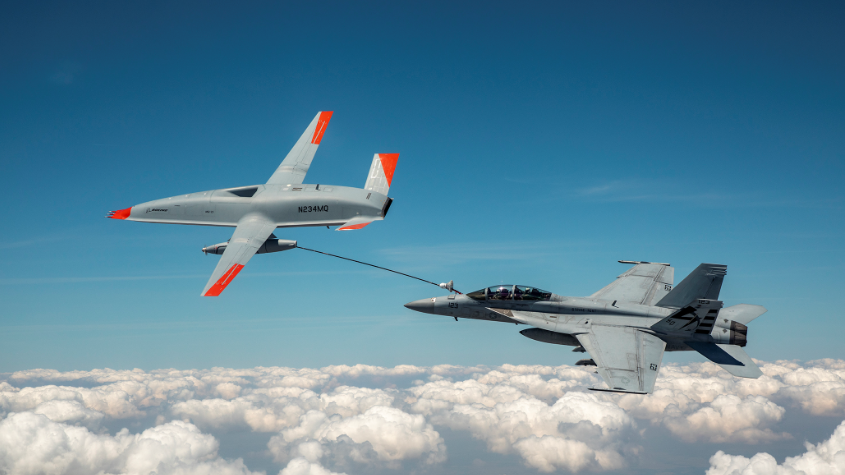Navy projects $300M annual savings in new aviation plan

An MQ-25 Stingray prototype, T1, refuels an F/A-18F Super Hornet in mid-air for the first time. (File)
WASHINGTON: The Navy projects it will save $300 million annually in coming years thanks to the efforts of an ongoing service-wide aviation maintenance effort, according to the Navy’s new future aviation plan.
The project, dubbed the Naval Sustainment System — Aviation [NSS-A], has identified methods “to include foreign object debris (FOD) prevention, maintenance reset, a fully integrated supply chain management system, optimized commercial and organic maintenance, and improved pricing postures.”
NSS-A was established in 2018 by then-Navy Secretary Richard Spencer and then-Vice Adm. Dewolfe Miller, commander of naval air forces. Its premise is to take the best practices of the commercial aviation industry and implement them across the service’s maintenance depots. The work has primarily been contracted out to the global management consulting firm Boston Consulting Group.
The service has reaped the benefit. In the following years the Navy attributed NSS-A as being a key reason it was able to meet former Defense Secretary Jim Mattis’ 80% mission-capable strike fighter goal. The Navy also subsequently established a similar program focused on shipyards, citing the success of NSS-A.
The Navy published its unclassified version of the “Navy Aviation Vision 2030-2035” late last week. In total, it outlines at a high level the key aircraft programs the service will pursue for the future such as the MQ-25A Stingray, MQ-4C Triton, MQ-8C Fire Scout, F/A-18 Super Hornets and the next generation strike fighter included in the Next Generation Air Dominance program, F/A-XX.
F/A-XX is “planned to replace the F/A-18E/F Super Hornet in the 2030s. Its specific capabilities and technologies are under development, however analysis shows it must have longer range and greater speed, incorporate passive and active sensor technology, and possess the capability to employ the longer-range weapons programmed for the future,” according to the document.
Aligning with Navy Secretary Carlos Del Toro recently published strategic guidance, the document also identifies China as its leading threat.
“In the early 2030s, Navy aviation can expect to face: increased People’s Liberation Army Navy aircraft carrier inventory [and] improved People’s Liberation Army Air Force capabilities and capacity (to include fighters, bombers, and special interest aircraft),” the document states.
The Navy’s aviation plan also highlights the importance of unmanned vehicles in particular to the service’s aviation fleet architecture. “Unmanned Air Systems (UAS) will fill diverse roles in the future air wing and the distributed surface Fleet in missions such as refueling, communications relay, logistics, airborne electronic attack, strike, and ISR&T,” according to the document.
On MQ-8C, the document states the Fire Scout’s earlier B variant is set to retire in fiscal year 2024. The Fire Scout will play a key role in providing mine countermeasures capabilities and is designed to replace the services provided by the service’s aging MH-53E Sea Dragon and MCM ship fleets.
The service anticipates it’ll begin training for its first air vehicle officers in Pensacola, Fla., who will ultimately be responsible for piloting the MQ-25A, the service’s carrier-bounded unmanned aerial tanker. That vehicle is expected to deploy in FY24.
The document also affirms MQ-4C Triton, a high-altitude, long-endurance surveillance aircraft, is on schedule to reach initial operational capability in FY23.